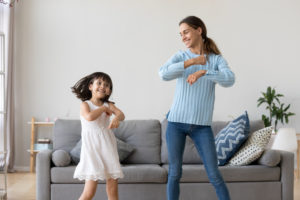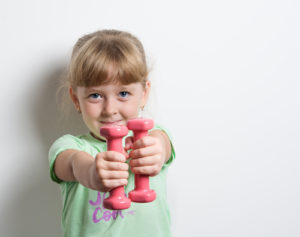Even moderate physical activity helps with sleep.
We know that physical activity benefits children’s health. But, did you know it also helps children sleep better? Even moderate activity can make a difference.
Sleep Latency
A 2009 study found that every hour of the day that children were inactive adds 3 minutes to the time it takes them to get to sleep. The authors of the study monitored a representative sample of 519 children. On average, it took 26 minutes to fall asleep. This period of time–how long it takes to get to sleep–is called “sleep latency.”
Regular exercise
The study showed that children who exercise regularly fall asleep faster and stay asleep longer than children who are sedentary. And, the more vigorous the activity, the faster they fell asleep.
Sleep and mood
Lack of good sleep and enough sleep can also negatively affect mood, cognitive function and behaviors.
Opportunities for movement
With less time being allocated to recess in schools, physical activity opportunities need to happen at home too. Even in schools where recess is a regular component, many children do not use this time for physical activity. Instead, they may opt for outdoor sedentary activities (chatting with groups of friends, for example). Children who by nature aren’t athletic may not choose active play and may need additional support and opportunities for movement.
My child doesn’t like sports: If your child doesn’t show interest in team sports, or resists traditional types of individual sports (hiking, biking, swimming, jogging), here are some non-traditional ideas for children of different ages:
 Dance:
Dance:
Dance party at home for younger children
Alternatives to ballet for other children: Scottish Highland dancing, Israeli dancing, square dancing, folk dancing (e.g. American folk dancing–Virginia reel).
Circus Arts: an alternative to gymnastics
More opportunities for this type of movement are opening up all around Washington State.
Seattle area, check out SANCA: https://sancaseattle.org/
Bellingham area: Bellingham Circus Guild http://bellinghamcircusguild.com/classes/
Olympia (teens) https://www.airboundarts.com/workshops–classes.html
 Strength training:
Strength training:
Children as young as 7-8 years old, as long as they can follow directions.
If your young child shows an interest in this, it should be supervised by someone knowledgeable. Demonstrate safety and proper techniques. Young children should focus on low weights and high repetition. Never allow young children to engage in “power lifting.”
Other ideas:
- Walking the dog
- Trampoline
- Roller skating and ice skating
Citation:
“Falling asleep: the determinants of sleep latency”
G M Nixon, J M D Thompson, D Y Han,D M O Becroft, P M Clark, E Robinson, K E Waldie, C J Wild, P N Black, E A Mitchell
Online First Arch Dis Child 2009; doi 10.1136/adc.2009.1574453

